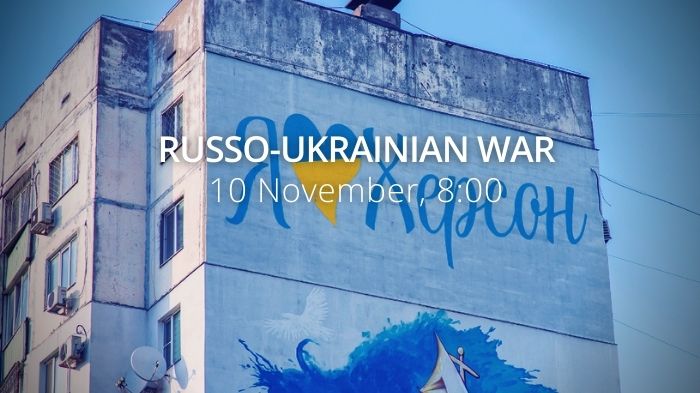Russia ordered troops to withdraw from the west (right) bank of the Dnipro River to the east (left) bank. Russian National Security Council Secretary Nikolai Patrushev met with senior Iranian officials. Russian and Ukrainian sources reported continued fighting along the Svatove-Kremmina highway and Bilohorivka, Luhansk Oblast. Ukrainian forces made territorial gains northeast of Kherson City and continued their successful interdiction campaign. Russian forces continued offensive operations in Donetsk Oblast. Russian federal subjects are struggling to pay mobilized personnel. Relatives of mobilized personnel continue to protest lack of payment and poor conditions. Russian occupation deputy head of Kherson Oblast Kirill Stremousov killed in a claimed car accident in rear Kherson Oblast. Bridges blown up en masse on occupied right bank of Kherson Oblast. Ukrainian Armed Forces liberate another two villages in Kherson Oblast. Russia carries out over 10 cyberattacks on strategic Ukrainian targets every day. More than 100,000 Russian military casualties in Ukraine, top US general says. East Europeans prepare for possible new Ukrainian refugee wave as winter nears. Germany Hands Over IRIS-t Missiles and Dingo Vehicles to Ukraine.
Daily overview — Summary report, November 10
A map of the approximate situation on the ground in Ukraine as of 00:00 UTC 10/11/22. pic.twitter.com/aze4kc7kEp
— War Mapper (@War_Mapper) November 10, 2022
The General Staff’s operational update regarding the Russian invasion as of 06.00 am, November 10, 2022 is in the dropdown menu below:
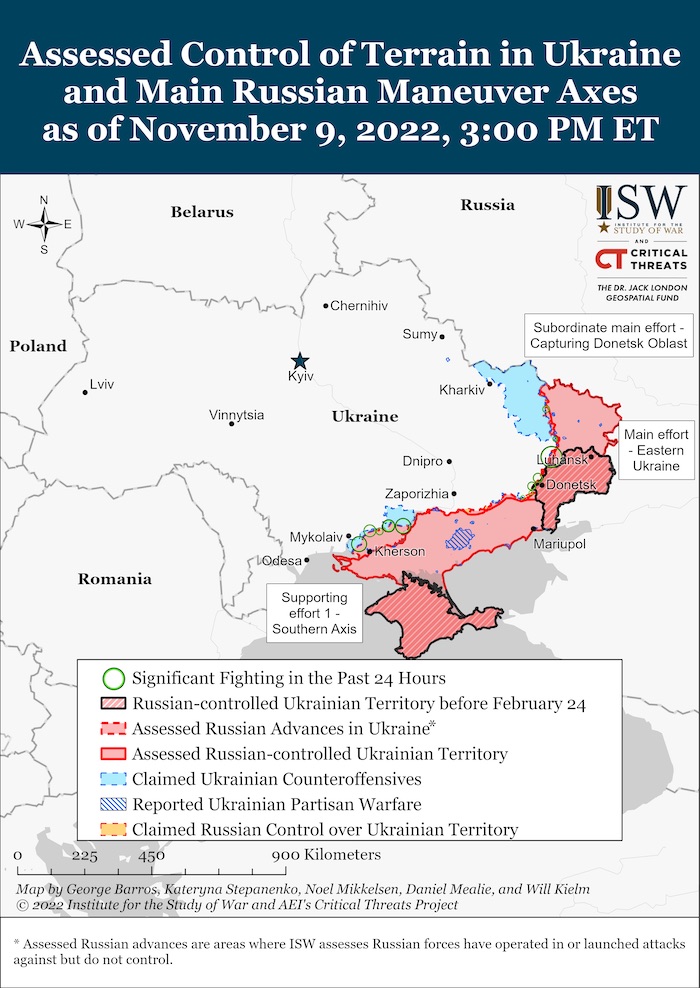
“Russian forces are trying to keep the temporarily captured territories, concentrating efforts on restraining the actions of the Defense Forces in certain areas. Conducts offensive actions in the Bakhmut and Avdiivka directions.
Over the past day, units of the Defense Forces of Ukraine repelled the attacks of the invaders in the areas of Novoselivka and Makiivka settlements of Luhansk oblast and Soledar, Klishchiivka, Mayorsk, Yakovlivka, Andriivka, Bilohorivka, Vesele, Nevelske, Pervomaiske and Novomykhailivka of Donetsk oblast.
Russian forces are shelling units of the Defense Forces along the contact line, carrying out border fortification equipment in separate directions and conducting aerial reconnaissance. It continues to strike critical infrastructure and civilian homes in violation of International Humanitarian Law, the laws and customs of war.
Over the past day, Russian forces launched 11 missile strikes, 22 airstrikes and more than 35 MLRS attacks. More than 30 settlements of Donetsk, Luhansk, Dnipropetrovsk, Zaporizhzhia, Mykolaiv, Sumy and Kherson oblasts were affected by this.
The situation in the Volyn and Polissya directions has not changed significantly. The Republic of Belarus continues to support the armed aggression of the Russian Federation against Ukraine, accepts and hosts Russian servicemen, and provides training grounds. The formation of a joint Russian-Belarusian grouping of troops is underway. The threat of enemy strikes and the use of attack UAVs from the territory and airspace of the Republic of Belarus remains.
Russian forces shelled in such other directions:
- in the Siversky direction - from artillery and MLRS, in the areas of Hasychivka, Chernihiv oblast, and Popivka, Petrushivka, Myropillya, Zapsillya, Nova Huta, Novovasylivka, and Starykove, Sumy oblast;
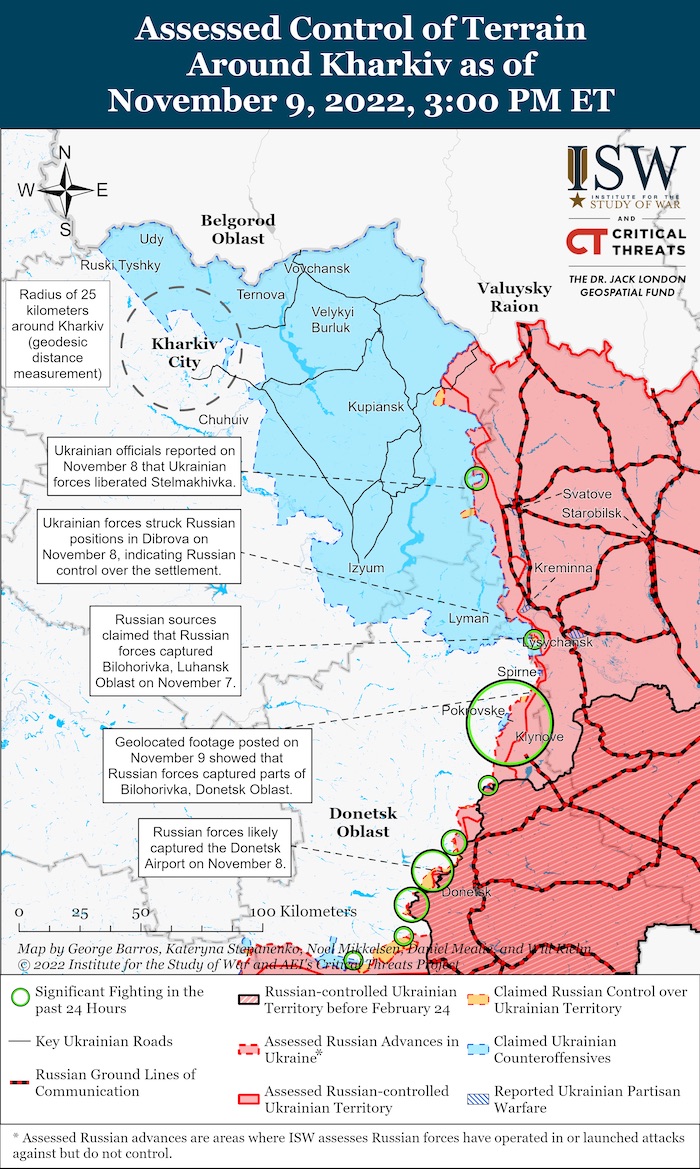
- in the Slobozhanskyi direction - from artillery of various types, in the areas of Hryhorivka, Kolodyazne, Strilecha, Vovchansk, Ohirtseve and Ternova settlements;
- in the Kupiansk and Lyman directions - from mortars, artillery and MLRS, in the areas of the settlements of Ploshanka, Berestove, Stelmakhivka, Myasozharivka, Spirne, Bilohorivka, Makiivka, Nevske, and Kislivka;
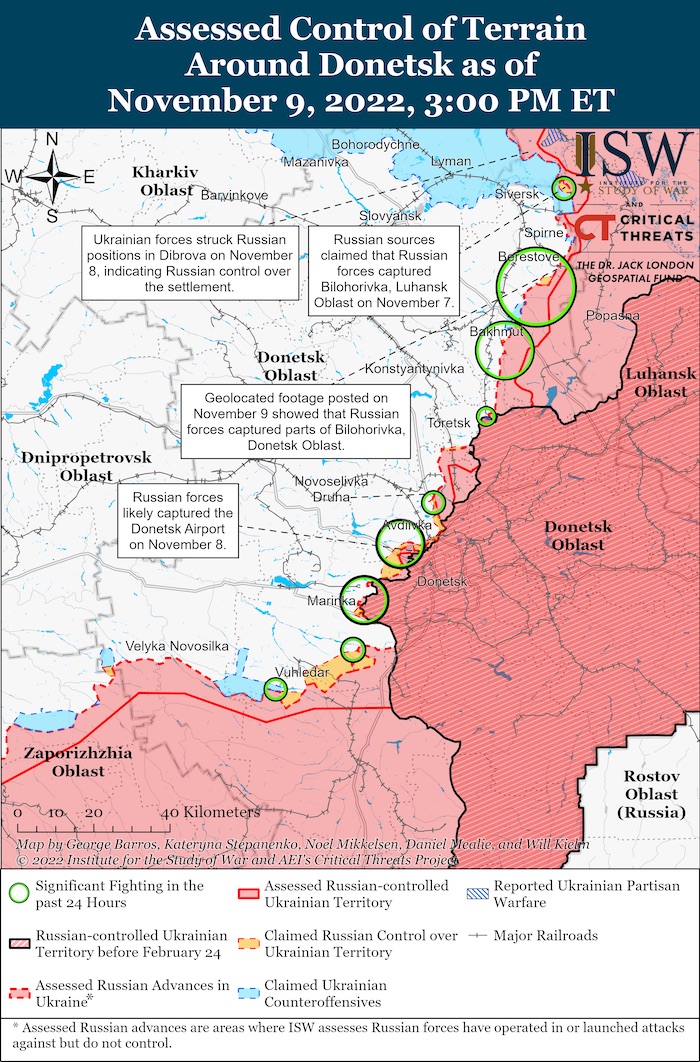
- in the Bakhmut direction - from tanks, mortars, artillery and MLRS, in the areas of the settlements of Bakhmut, Bakhmutske, Soledar, Ivanhrad, Yakovlivka, Mayorsk, Zelenopillya and New York;
- in the Avdiivka direction - from tanks, mortars, artillery and MLRS, in the areas of Vuhledar, Nevelske, Mariinka, Novomykhailivka, Krasnohorivka and Vesele settlements;
- in the Novopavlivka and Zaporizhzhia directions - from tanks and the entire variety of artillery, in the areas of the settlements of Prechystivka, Velyka Novosilka, Pavlivka, Hulyaipilske, Vremivka, Zaliznychne, Novodanylivka, Mala Tokmachka, Novopil, Mali Shcherbaky, and Poltavka;
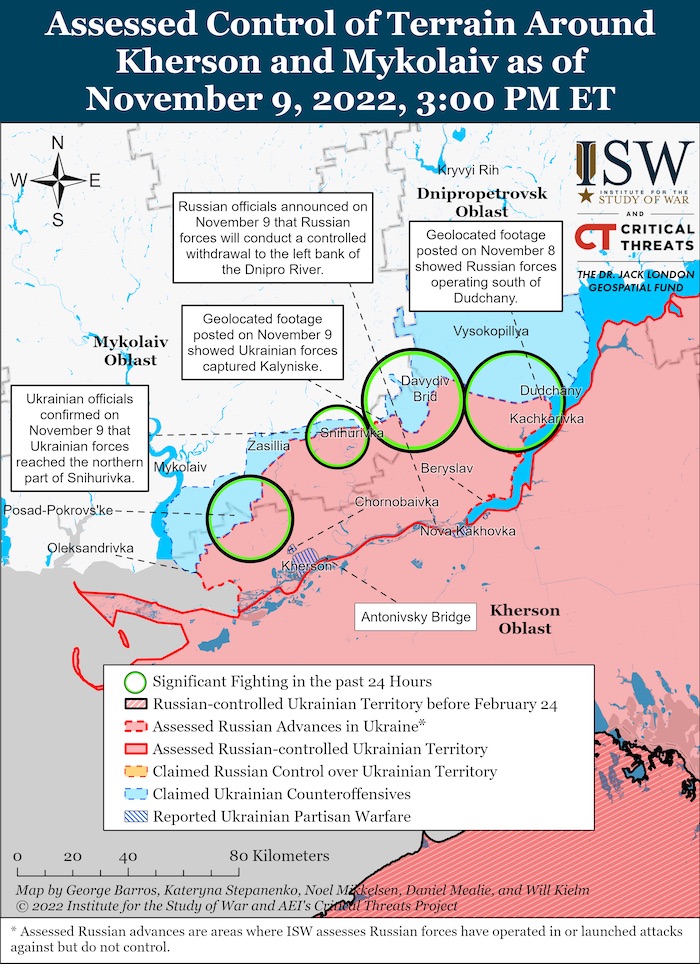
- In the Pivdennyy Buh direction, from tanks and artillery of various calibres in the areas of Pravdyne, Myrne, Ternovi Pody, Sukhyi Stavok, Zolota Balka and Marhanets settlements. In addition, Russian forces continued to conduct aerial reconnaissance, actively using UAVs. Made more than 15 flights.
According to available information, the internal affairs bodies of the Russian Federation in the city of Tolyatti, Samara Region received an order to recruit 1,000 candidates for service in the temporarily occupied territories of Ukraine. At the same time, the city's chemical enterprises are working on additional fundraising to support the regional division. This arouses the indignation of the employees, who, even without this, have monthly deductions for the support of the mobilized, who participate in the war on the territory of Ukraine.
According to detailed information, the so-called evacuation of the population from the city of Kherson has been stopped due to the lack of willing people. In the city, the occupation authorities stopped issuing wages and social benefits.
[The moral and psychological condition of mobilized Russian citizens undergoing training in the Kursk and Bryansk regions is significantly deteriorating due to the difference between the picture of Russian propaganda and the actual situation, inhumane conditions of stay and lack of promised payments.]
[Russian units undergoing training in the area of the city of Baranovichi, Brest region, were issued obsolete weapons and equipment - metal helmets of the Second World War model and means of protection from the period of the 60-70 years of the last century. In addition, a large part of small arms, namely AK-74 assault rifles, are in non-working condition due to poor storage conditions.]
[According to detailed information, the Russian occupiers are taking away looted property and stolen cars from the city of Sievierodonetsk, Luhansk oblast. Looting takes place under cover and accompanied by representatives of the occupation's so-called state security agencies.]
In the temporarily occupied territory of the Autonomous Republic of Crimea, in the city of Dzhankoi, the invaders transferred a civilian hospital to a military hospital. Up to 800 wounded occupiers are in it.
Aviation of the Defense Forces of Ukraine struck Russian forces 6 times during the past day. 2 areas of concentration of personnel, weapons and military equipment, as well as 4 positions of Russian anti-aircraft defence equipment, were damaged. Over the past day, the Defense Forces shot down 5 "Shakhed" and 3 "Orlan" UAVs in different directions.
Over the past day, soldiers of the Ukrainian missile forces and artillery hit one command post, one area of concentration of manpower, weapons and military equipment, an ammunition depot and other important military objects of the occupiers.“
Military Updates
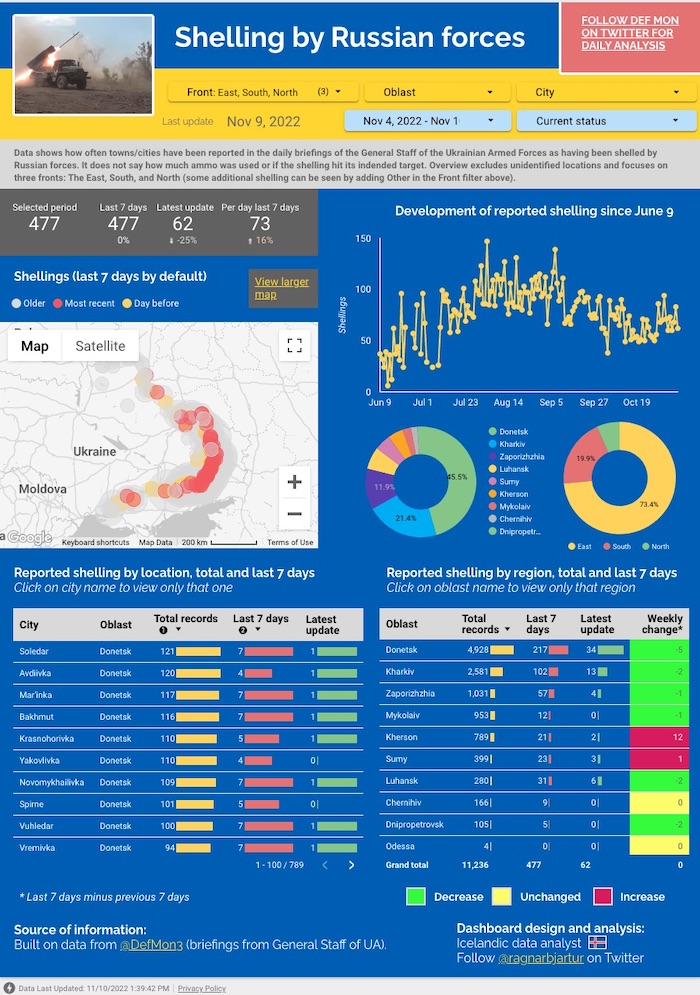
Ukrainian Armed Forces liberate another two villages in Kherson Oblast, Ukrainska Pravda reports. “Ukrainska Pravda’s sources have confirmed that soldiers of the Armed Forces of Ukraine have reached Pravdyne. The Russians left on the night of 8-9 November. Up until that moment, heavy fighting had been going on there. Ukraine’s Armed Forces liberated Kalynivske on the afternoon of Wednesday.”
Read more on the liberation of Kherson Oblast here.
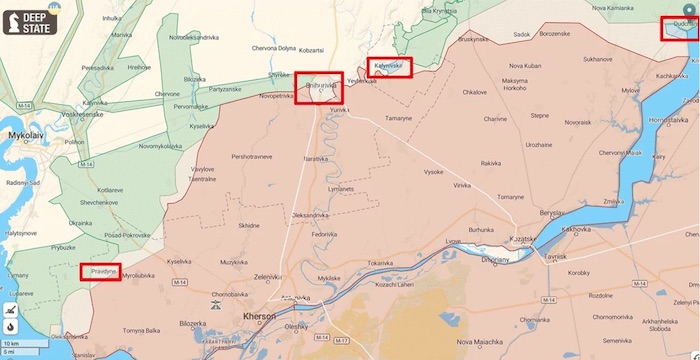
Russians entrench in Kherson Oblast, north of Crimea, Ukrainska Pravda reports, citing Benjamin Pittet, an open-source intelligence analyst. “According to the satellite images posted by the analyst, the Russian occupiers are digging trenches in Crimea’s north. In particular, Russia has restored trenches near the Chonhar entry-exit checkpoint, which is located between Crimea and Kherson Oblast. Moreover, new trenches were dug.
The same situation is observed in the northwestern part of Crimea, near the city of Armiansk. As Pittet points out, Russians have been renewing old trenches and digging new ones there. Besides, a large defence trench was dug in Novotroitske (Henichesk district in Kherson Oblast). A lot of trenches can be detected throughout the entire region.”
https://twitter.com/EuromaidanPress/status/1590500232705417216
Special Forces of Ukraine's National Guard destroy Russian military convoy in Donetsk Oblast, Ukrainska Pravda reports, citing the press service of the National Guard of Ukraine. “Special Forces of the National Guard discovered and destroyed a convoy of Russian military equipment in Donetsk Oblast. As a result of Ukrainian fire, three tanks and two infantry fighting vehicles were destroyed and their crew killed.”
Russia carries out over 10 cyberattacks on strategic Ukrainian targets every day, Ukrainska Pravda reports, citing Illia Vitiuk, head of the Cybersecurity Department of the Security Service of Ukraine, in an interview with "Liga.net". "Energy, infrastructure and logistics are priority targets for the Russian secret services. The latest attacks on the combined heat and power plants were also accompanied by cyberattacks. We were expecting this scenario, so none of them were effective.
Sometimes we have information about where Russian forces will strike in the coming days or weeks, and our task is to prevent this. The public are unaware of most cyberattacks, but Russia carries out an average of more than 10 cyberattacks per day.
According to Vitiuk, if they had not been fended off, the consequences would have been "extremely serious". He explained that cyberattacks can be far more effective and cheaper than rocket attacks, because a simultaneous attack on all the regional power companies could turn off the lights throughout the country.”
https://twitter.com/EuromaidanPress/status/1590510048135958528
According to British Defence Intelligence, (last 48 hours):
- On 09 November 2022, Russian Defence Minister Sergey Shoygu ordered the withdrawal of Russian forces from the west bank of the Dnipro river in Kherson, southern Ukraine. General Sergei Surovikin, commander of the Russian forces in Ukraine, confirmed they will withdraw to defensive positions along the Dnipro River, citing re-supply issues as the primary reason for the decision.
- Russia’s ability to sustain its forces on the west bank of the Dnipro river had been placed under pressure by Ukrainian strikes on Russia’s resupply routes. In retreating, Russian forces have destroyed multiple bridges and likely laid mines to slow and delay advancing Ukrainian forces. The loss of Kherson’s west bank will likely prevent Russia from achieving its strategic aspiration of a land bridge reaching Odesa.
- With limited crossing points, Russian forces will be vulnerable in crossing the Dnipro River. It is likely that the withdrawal will take place over several days with defensive positions and artillery fires covering withdrawing forces.
- Russian efforts to repair the Crimean Bridge continue but it is unlikely to be fully operational until at least September 2023. On 8 November the road bridge was due to be closed to allow the movement and installation of a replacement 64-metre span. Three more spans will be required to replace the damaged road sections.
- Although Crimean officials have claimed these additional spans will be in place by 20 December, a briefing provided to President Putin added that works to the other carriageway would cause disruption to road traffic until March 2023.
- Replacement of the damaged rail bridge has been contracted for completion by September 2023, although Russia’s Deputy Prime Minister stated the repair timeline would be expedited. One track is open, but rail transport remains restricted. Repair activity will be heavily dependent on weather conditions through the winter months.
The Crimean bridge attack has disrupted Russian logistics supplies for Crimea and southern Ukraine, reducing Russia’s ability to move military equipment and troops into the area by rail or road. The damage to the bridge, the recent attack on the Black Sea Fleet in Sevastopol and the probable withdrawal from Kherson all complicate the Russian government’s ability to paint a picture of military success.
Losses of the Russian army
As of Thursday 10 November, the approximate losses of weapons and military equipment of the Russian Armed Forces from the beginning of the invasion to the present day:
- Personnel – about 78690 (+740),
- Tanks – 2804 (+3),
- Armoured combat vehicles – 5682 (+16),
- Artillery systems – 1805 (+3),
- Multiple rocket launchers –MLRS - 393 (+0),
- Air defence means – 205 (+0),
- Aircraft - 278 (+0),
- Helicopters - 260 (+0),
- Automotive technology and fuel tanks – 4242 (+15),
- Vessels/boats - 16 (+0),
- UAV operational and tactical level – 1499 (+16),
- Special equipment – 159 (+0),
- Mobile SRBM system – 4 (+0),
- Cruise missiles – 399 (+0)
More than 100,000 Russian military casualties in Ukraine, top US general says, Reuters reports. “America's top general estimated on Wednesday that Russia's military had seen more than 100,000 of its soldiers killed and wounded in Ukraine, and added Kyiv's armed forces "probably" suffered a similar level of casualties in the war. […]
But Milley's remarks offer the highest US estimate of casualties to date in the nearly nine-month-old conflict, and came as Ukraine and Russia face a potential winter lull in fighting that experts say could offer an opportunity for some kind of negotiations. […] Milley said the conflict so far had turned anywhere from 15 million to 30 million Ukrainians into refugees, and killed probably 40,000 Ukrainian civilians.”
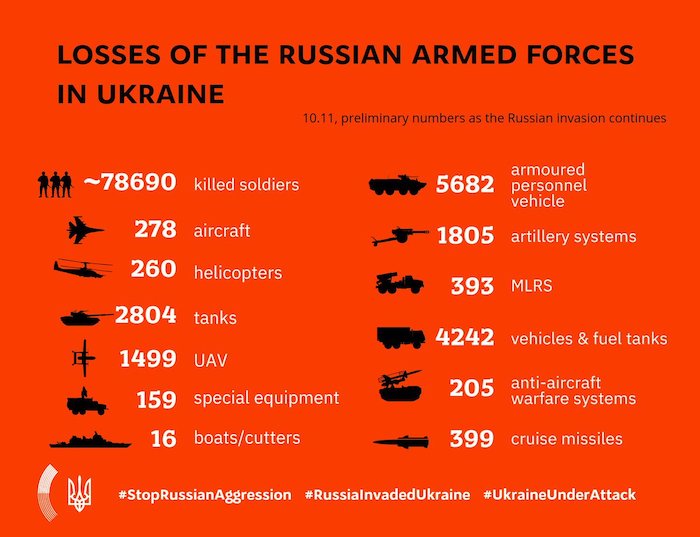
Humanitarian
East Europeans prepare for possible new Ukrainian refugee wave as winter nears, Reuters reports. “Eastern European countries are preparing to reopen reception centres and are restocking food supplies in anticipation of a possible fresh surge in Ukrainian refugees as winter looms and Russia targets Ukraine's power grid and heating plants.
Some 6.9 million people are believed displaced internally within Ukraine, often living in very tough conditions, and the Slovak government's contingency plan envisages the possible inflow of hundreds of thousands of them in coming months. […]
After an initial surge following Russia's invasion on Feb. 24, the number of refugees heading west out of Ukraine dropped in late spring. There has been no big uptick in numbers so far this autumn but charities say there are now signs of increased movement across the borders and are stepping up preparations. An increase in numbers is being felt, and is expected. It is currently up 15%, said Roman Dohovic, an aid coordinator for the eastern Slovak city of Kosice. […]
Slovakia's contingency plan reckons as many as 700,000 people could cross onto its territory over three months due to tumbling temperatures and continued heavy fighting in parts of eastern and southern Ukraine. A large number of (Ukraine's) internally displaced people are currently temporarily housed in conditions that are not suitable for the winter. Further escalation of the conflict is also a risk, the plan said. […]”
Ukraine PM: evacuation of cities 'would not make sense' at present, Reuters reports. “Ukrainian Prime Minister Denys Shmyhal said on Tuesday he saw no need at present to evacuate Kyiv or any other cities that are not near the front lines in the war against Russia.
He made his comments at a cabinet meeting following Russian attacks on Ukraine's energy system, and after the mayor of Kyiv told residents to consider everything including a worst-case scenario where the capital loses power and water completely
.”
President's Office creates human rights headquarters amid International Red Cross inaction, Ukrainska Pravda reports, citing the Head of the Office of the President, Andrii Yermak. “The International Committee of the Red Cross did not agree to delegate any representatives to the mission which was supposed to go to the contact line and demand that Russia provide access to the places where Ukrainian prisoners were being detained.
At my suggestion, the participants in the meeting decided to create a human rights information headquarters, which will regularly publish important data for the world human rights community and the media on human rights violations during the period of Russian aggression. Yermak called on Ukrainian and international human rights organisations to join the work of the headquarters.
According to Yermak, the headquarters will work continuously and serve as a platform for information on matters relating to Ukrainian prisoners held by the invaders.”
Ukraine wants to extend ‘grain deal’ by at least one year, revise provisions, Ukrinform reports. “Ukraine wants the Black Sea grain export deal expanded to include more ports and goods and hopes a decision to extend the agreement for at least a year will be taken next week. The relevant statement was made by Ukrainian Infrastructure Deputy Minister Yurii Vaskov in an interview with Reuters. […] The deal, which eased a global food crisis by unblocking three major Ukrainian ports during Russia’s invasion, expires on November 19.
According to Vaskov, the Ukrainian side offered an extension of at least one year to Türkiye and UN, as well as a broadening of the deal to include the ports of the southern Mykolaiv region, which provided 35% of Ukrainian food exports before Russia’s invasion.
Additionally, Ukraine demanded that mandatory inspections of ships that are involved in food transportation be “streamlined”, as Kyiv believes Russia is deliberately slowing down inspections to reduce the speed of exports. We are already ... demanding inspections be streamlined or inspections of departed (ships) be cancelled, because it makes no sense. Or else increase the number of inspection teams, Vaskov noted.
In his words, inspectors of the Joint Coordination Center that oversees the deal conducted only 12 inspections per day, but that it was necessary to make 25-30 inspections. When Türkiye and the UN did their own inspections, they proved it was possible to carry out more than 40 inspections a day. Now that Russia has returned ... we again have a total of 12 inspections per day. […]
Vaskov said neither the UN nor Türkiye had informed Kyiv about the conditions for extending the agreement put forward by Russia.”
Millions of refugees from Ukraine have crossed borders into neighbouring countries, and many more have been forced to move inside the country. The escalation of conflict in Ukraine has caused civilian casualties and destruction of civilian infrastructure, forcing people to flee their homes seeking safety, protection and assistance the UNHCR reports. As of 8 November:
| Individual refugees from Ukraine recorded across Europe: | 7,822,344 |
| Hungary, Republic of Moldova, Poland, Romania, Slovakia | 2,318,940 |
| Russian Federation, Belarus | 2,868,966 |
| Other European countries | 2,634,438 |
| Refugees from Ukraine registered for Temporary Protection or similar national protection schemes in Europe: | 4,697,154 |
| Hungary, Poland, Romania, Slovakia | 2,303,627 |
| Other European countries | 2,393,527 |
| Border crossings from Ukraine (since 24 February 2022): | 15,107,523 |
| Border crossings to Ukraine (since 28 February 2022): | 7,562,124 |
Environment
Luhansk Oblast turns into Russian burial site, harming environment, Ukrainska Pravda reports. “Serhii Haidai, Head of the Luhansk Oblast Military Administration, has said that environmental problems occurred in the oblast due to the large number of dead people who were buried spontaneously, including occupiers. On the battlegrounds, Luhansk Oblast is becoming one large Russian burial site...
The environment in Luhansk Oblast is disturbed by a large number of dead people who were spontaneously buried. And the Ruscists’ remnants that no one is going to bury. Because of this situation, there is already a problem with groundwater, which is contaminated. […]
Haidai has stated that it would take at least 10 years to clear the main roads and territories of critical infrastructure facilities and residential areas in Luhansk Oblast off the mines. It will take much more to clear the entire occupied part of Luhansk Oblast off the mines. In particular, a problem in demining will be caused by modern devices, such as plastic mines, which a metal detector cannot find. Therefore, it is dangerous for civilians to return to the liberated cities and towns right now.”
️Legal
Five militants involved in the occupation of Mariupol and Sievierodonetsk receive prison sentences, Ukrainska Pravda reports, citing Security Service of Ukraine (SSU) press service. “Five militants from illegal armed groups in the "L/DNR" [the so-called Luhansk/Donetsk People’s Republics] who took part in the occupation of Mariupol and Sievierodonetsk will spend 10 to 13 years behind bars. They were captured by Ukrainian forces during hostilities near the settlement of Bilohorivka, Luhansk Oblast. […]
Based on the evidence collected, the court found the defendants guilty of high treason, participation in the activity of a terrorist organization, and participation in the activities of illegal armed groups.”
430 children were killed, 828 children injured, 10,764 deported by foe forces, and 262 reported missing - the Office of the Prosecutor General of Ukraine reports as of November 9. 2,719 educational establishments are damaged as a result of shelling and bombings, 332 of them are destroyed fully.
A Russian court is willing to kill 60-year-old a Crimean Tatar political prisoner, heart attack or not.
#Russia court willing to kill 60-year-old #CrimeanTatar political prisoner, heart attack or not#FreeDzhemilGafarov #LetMyPeopleGo #Ukraine #StandWithUkraine #StopRussiahttps://t.co/rlOVDDmtQy pic.twitter.com/sHUenKEotp
— Halya Coynash (@halyapuff) November 9, 2022
In Moldova, criminal case was opened due to Russian missiles that violated airspace.
Read more here.
https://twitter.com/EuromaidanPress/status/1590498219779272705
Support
NSDC Secretary calls on the West to increase military support: We are looking for all types of weapons, Ukrinform reports. “Ukraine is suffering enormous military and civilian losses, defending the eastern frontier of NATO, while NATO members debate how much aid to provide to Kyiv. The relevant statement was made by National Security and Defense Council of Ukraine (NSDC) Secretary Oleksiy Danilov in an interview with The Globe and Mail.
If someone in some capital is considering whether we should receive extra military support or not, I would like to underline that at this very moment Putin’s modern fascists are killing our citizens. Military, civilians and, most horrifically, they kill our children. Not everyone in the world is taking that seriously enough, Danilov said.”
Germany Hands Over IRIS-t Missiles and Dingo Vehicles to Ukraine, European Pravda reports. “Germany has added missiles for IRIS-T and Dingo armoured vehicles to its list of arms aid to Ukraine, which is published on the federal government's website.
Compared to the previous week they have added 30 Dingo armoured vehicles; missiles for Iris-T air defence system previously provided to Ukraine; four more Anti-Drone Sensors and Jammers (in addition to 14 last week); five heavy-duty M1070 Oshkosh semi-trailers.
During his visit to Kyiv, German President Frank-Walter Steinmeier announced the provision of two additional MARS multiple rocket launchers and four Panzerhaubitze 2000 howitzers to Ukraine.”
UK boosts support for Ukrainian troops through winter, Reuters reports. “Britain is stepping up its support for Ukrainian soldiers through the winter, Defence Secretary Ben Wallace told Reuters on Wednesday, following weeks of Ukrainian advances towards the southern city of Kherson.
Wallace joined NATO Secretary General Jens Stoltenberg to observe the training of Ukrainian troops in the southeast English town of Lydd, as Britain announced the delivery of a further 12,000 extreme cold-weather sleeping kits for Ukraine. Winter is approaching and that is an important challenge for both sides, Wallace said. So we're determined ... to give Ukrainian soldiers the best basic skills because we already know that the Russian military aren't doing that.
Later, Britain's Ministry of Defence said it would soon complete the delivery of 1,000 additional surface-to-air missiles to Ukraine's armed forces. The equipment includes launchers and missiles and is capable of shooting down air targets including Russian drones and cruise missiles, it said.”
Dutch forces to train Ukrainian soldiers within EU mission, Ukrinform reports, citing RTL Nieuws. "The Netherlands plans to send 50 to 100 military personnel to participate in the EU mission to train the Ukrainian military. This number is an addition to the 90 servicemen who are currently training the Ukrainian military in Great Britain.
It is known that, in particular, Dutch servicemen will teach Ukrainians tactical medicine, explosives disposal, tactical and technical training in weapons systems, and training of staff officers of battalions and brigades.
As reported, the Netherlands will provide Ukraine with EUR 15 million worth of anti-aircraft missiles for air and missile defense.”
17 EU countries send 500 power generators to Ukraine, Ukrainska Pravda reports, citing European Pravda and Olha Stefanishyna, Deputy Prime Minister for European and Euro-Atlantic Integration of Ukraine. "Thank you for standing with Ukraine against Russian terror. For weeks, Russia has been attacking Ukraine's energy infrastructure. 17 European Union member states heard our plea and sent 500 power generators to help Ukrainians to survive winter."
European Commission officially proposes to provide Ukraine with up to €18 billion in macro-financial assistance in 2023, Ukrainska Pravda reports, citing European Pravda. “On 9 November, the European Commission proposed an unprecedented support package of up to €18 billion for Ukraine for 2023. This assistance will be provided in the form of concessional loans, which will be disbursed in regular instalments starting from 2023.
This stable, regular and predictable financial assistance – averaging €1.5 billion per month – will help cover a significant part of Ukraine's short-term funding needs for 2023, which the Ukrainian authorities and the International Monetary Fund estimate at €3 to €4 billion per month," the European Commission said. The support proposed by the EU would need to be matched by similar efforts from other major donors in order to cover all of Ukraine's financing needs for 2023.
As European Pravda noted, thanks to these funds, Ukraine will be able to continue to pay salaries and pensions and maintain essential public services such as hospitals, schools and housing for relocated people. It will also allow Ukraine to ensure macroeconomic stability and restore critical infrastructure destroyed by Russia.
The support should be accompanied by reforms to further enhance the rule of law, good governance, and anti-fraud and anti-corruption measures in Ukraine.”
New Developments
https://twitter.com/EuromaidanPress/status/1590450697207615489
Russian occupiers report Kherson occupation leader Stremousov’s death. Read more.
- Russia surrenders the West Bank of Kherson, Ukrainska Pravda reports, citing RIA Novosti. “Sergei Surovikin, the new commander of the Russian occupation forces in Ukraine, has announced that the Russian Federation is transferring its troops to the left bank of the Dnipro River, which means that the Russians are leaving Kherson. "It is appropriate to organise defence along the barrier border of the Dnipro River, on its left bank... The decision to defend the left bank of the Dnipro is not an easy one. At the same time, we will save the lives of our military and the combat capability of the troops... The manoeuvre of the troops will be carried out as soon as possible. The troops will occupy the prepared defensive positions on the left bank of the Dnipro."
Russia announces troop withdrawal from western-bank Kherson Oblast, by Euromaidan Press--read more.
Russia announces troop withdrawal from western-bank Kherson Oblast
Commander of the occupying troops Surovikin announced that the Russians will occupy defensive positions along the east bank of the Dnipro https://t.co/ByHwGm0nLt pic.twitter.com/LBDmLNLv7R
— Euromaidan Press (@EuromaidanPress) November 9, 2022
- Biden: Russia's evacuation of Kherson shows they have real problems, Reuters “Biden told reporters it was interesting that Russia had waited until after the US congressional election to announce the withdrawal. It's evidence of the fact that they have some real problems with the Russian military, he said.”
- No conditions: Russian Foreign Ministry wants Ukraine to show "good will" and negotiate, Ukrainska Pravda reports, citing RIA Novosti. “Andrey Rudenko, Deputy Minister of Foreign Affairs of Russia, said that Russia had no preconditions for starting negotiations with Ukraine. There are no preconditions on our part [for starting the negotiations], except for the main one – that Ukraine should show goodwill."
- Russia suddenly announces its readiness for negotiations "taking into account current state of affairs", Ukrainska Pravda reports, citing RIA Novosti. “Maria Zakharova, Spokesperson for the Ministry of Foreign Affairs of the Russian Federation, has said that Russia is ready to negotiate with Ukraine "taking into account the current state of affairs". We are still open to negotiations. We have never refused them. We are ready to conduct them, of course, taking into account the current state of affairs."
- Ukraine's MFA on Proposals for Negotiations from Moscow: "Smokescreen", European Pravda "The statement of the Russian Foreign Ministry is another smokescreen. Russian officials mention negotiations every time Russian troops are defeated on the battlefield. Moscow is not interested in restoring peace in Ukraine. By pretending to be ready for dialogue, the Russian Federation is trying to buy time to regroup its units, prepare the recently mobilised Russians, get more weaponry, eliminate the shortcomings of logistics, and then resort to new waves of aggression with new forces. We already went through this in 2014-2015," Oleh Nikolenko, [spokesperson for the Ministry of Foreign Affairs of Ukraine,] noted. He emphasised that everything that Russia continues to do does not in any way indicate its interest in peace negotiations.”
Putin’s peace talks ruse: why the West should listen to Ukraine
Putin’s peace talks ruse: why the West should listen to Ukraine by Euromaidan Press. Read more.
- Ukraine is not being pushed to negotiate with Russia, Ukrainska Pravda “Foreign partners are not trying to persuade the Ukrainian authorities to negotiate with Russia. They are not pushing us to enter into negotiations but are simply saying that it is desirable not to refuse [Russia] so categorically […]. In addition, Ukrainska Pravda’s contacts in diplomatic circles deny that Western partners are putting pressure on Ukraine and calling for negotiations with Russia. […] There are very vague conversations about how to move forward," said one of Ukrainska Pravda’s sources who is involved in international negotiations.”
- Russia's Putin will not attend G20 summit in Bali- Indonesian official, Reuters “President Vladimir Putin will not attend a gathering of leaders from the Group of 20 (G20) nations in Bali next week, an Indonesian government official told Reuters on Thursday. Putin will be represented by Russian Foreign Minister Sergei Lavrov, Jodi Mahardi, a spokesperson for the Coordinating Minister of Maritime and Investment affairs, said.”
- Russia, US to hold first talks under nuclear treaty since Ukraine war -State Dept, Reuters “The United States and Russia are expected to meet soon and discuss resuming inspections under the New START nuclear arms reduction treaty that have been paused since before Russia's invasion of Ukraine, US State Department spokesperson Ned Price said on Tuesday.
Russia in August suspended cooperation with inspections under the treaty, blaming travel restrictions imposed by Washington and its allies over Moscow's February invasion of Ukraine, but said it was still committed to complying with the provisions of the treaty.”
- Putin issues decree to protect "traditional Russian values", Ukrainska Pravda reports, citing the Kremlinwebsite and TASS. “Russian president Vladimir Putin has approved the basic principles of the state policy to preserve and strengthen so-called "traditional Russian spiritual and moral values". The Russian Federation considers traditional values to be the basis of Russian society; Russia regards the actions of the United States and other unfriendly states as a threat to traditional values.”
NATO Secretary General Jens Stoltenberg said at a briefing in London that it'll be possible to make conclusions about what is happening in Kherson later, but reminded that Ukraine has already repeatedly forced Russian troops to leave occupied territories.https://t.co/AINKhcUPcs
— Euromaidan Press (@EuromaidanPress) November 9, 2022
Assessment
- On the war.
The Institute for the Study of War has made the following assessment as of 9 November, 2022:
“The Russian Ministry of Defense (MoD) ordered Russian forces on the west (right) bank of the Dnipro River to begin withdrawing to the east (left) bank on November 9. Russian Defense Minister Sergei Shoigu ordered the withdrawal of Russian troops across the Dnipro River during a highly staged televised meeting with Commander of the Russian Armed Forces in Ukraine Army General Sergey Surovikin on November 9. During the televised meeting, Surovikin recommended the withdrawal and Shoigu accepted his decision, giving Surovikin the task of ensuring the “safe transfer of personnel, weapons, and equipment” to the east (left) bank. Shoigu and Surovikin’s statements mark the beginning of a steady, fighting withdrawal by Russian troops across the Dnipro to prepared positions on the east (left) bank to preserve the combat power of Russian units, including elements of the 76th and 106th Airborne Assault Divisions and 22nd Army Corps. Surovikin notably stated that half of the troops withdrawn from the west bank of the Dnipro will be redeployed to other areas of Ukraine. The entire Russian contingent will take some time to withdraw across the Dnipro River and it is still unclear if Russian forces will be able to conduct the withdrawal in relatively good order under Ukrainian pressure. The battle of Kherson is not over, but Russian forces have entered a new phase—prioritizing withdrawing their forces across the river in good order and delaying Ukrainian forces, rather than seeking to halt the Ukrainian counteroffensive entirely.
The Ukrainian counteroffensive in the Kherson direction since August—a coordinated interdiction campaign to force Russian forces to withdraw across the Dnipro without necessitating major Ukrainian ground offensives—has likely succeeded. As ISW has observed over the previous months, Ukrainian forces engaged in a purposeful and well-executed campaign to target Russian concentration areas, military assets, and logistics nodes throughout Kherson Oblast to make continued Russian positions on the west bank untenable without having to conduct large-scale and costly ground maneuvers to liberate territory. Ukrainian troops launched constant attacks on bridges across the Dnipro River and targeted supply centers and ammunition depots on the east bank of the Dnipro that degraded the ability of Russian forces to supply the grouping on the west bank; Ukrainian forces combined these strikes with prudent and successful ground attacks on key locations such as Davydiv Brid. This campaign has come to fruition. Surovikin directly acknowledged that Russian forces cannot supply their grouping in Kherson City and the surrounding areas due to Ukrainian strikes on critical Russian supply lines to the west bank. Russian sources noted that the withdrawal is a natural consequence of targeted and systematic Ukrainian strikes that cost the Russian grouping on the west bank its major supply arteries, which gradually attritted their overall strength and capabilities.
The Russian withdrawal from the west bank of the Dnipro is unlikely to be a trap meant to lure Ukrainian troops into costly combat near Kherson City, as some Ukrainian and Western sources have suggested. ISW has previously observed many indicators that Russian forces, military and economic assets, and occupation elements have steadily withdrawn from the west bank across the Dnipro River, and Russian officials have been anticipating and preparing for withdrawal in a way that is incompatible with a campaign to deceive and trap Ukrainian troops. Russian commanders will certainly attempt to slow Ukrainian advances to maintain an orderly withdrawal, and some forces may remain to delay Ukrainian troops in Kherson City itself—but this fighting will be a means to the end of withdrawing as many Russian units as possible in good order.
The Russian information space predictably reacted to the announcement of the withdrawal with varying degrees of ire and concern. Several Russian milbloggers emphasized that the withdrawal is the natural consequence of systematic failures within Russian military and command structures and framed the withdrawal as an inevitable result of political nuances beyond the realm of military control. Russian sources also emphasized that this is a major defeat for Russian forces because they are losing territory that Russia annexed and claims as its own.
However, many prominent voices in the milblogger space sided with Surovikin and lauded the decision as a necessary one, indicating that Russian leadership has learned from the information effects of the disastrous Russian withdrawal from Kharkiv Oblast in mid-September. A prominent Russian milblogger that has previously stridently criticized the conduct of Russian operations stated that Surovikin “got the inheritance he got” managing operations in Kherson Oblast, and implied that Surovikin did the best he could under the circumstances, so he ultimately cannot be blamed. Wagner Group financier Yevgeny Prigozhin voiced his support for the withdrawal and called it the “greatest achievement” made by Surovikin due to Surovikin’s stated desire to preserve the safety of Russian troops. Chechen leader Ramzan Kadyrov agreed with Prigozhin’s assessment and claimed Surovikin saved thousands of lives and is seeking more advantageous positions. These responses, particularly from Kadyrov and Prigozhin, are markedly different from scathing critiques previously leveled at Commander of the Grouping of Russian forces “Center” in Ukraine Colonel General Alexander Lapin following massive Russian losses in eastern Kharkiv and northern Donetsk oblasts. Surovikin has steadily established an informational cover for his decision-making and the eventual Russian withdrawal from positions in Kherson Oblast since the announcement of his appointment as theatre commander of Russian Forces in Ukraine. Surovikin stated that Russian leadership will need to make “difficult decisions” regarding Kherson Oblast as early as October 19. The Kremlin and senior Russian commanders appear to have learned informational and military lessons from previous failures and will likely apply these to the presentation and conduct of this withdrawal. Russian President Vladimir Putin has not commented on the withdrawal as of this publication, suggesting that the Kremlin is framing the withdrawal as a purely military decision.
Ukrainian military officials largely maintained operational silence on the situation in Kherson Oblast on November 9, despite confirmation by Russian military officials that Russian troops are withdrawing from the west bank of the Dnipro River. Ukraine’s Southern Operational Command noted that Russian forces continued defensive actions and are trying to prepare positions for a retreat. Advisor to the Ukrainian President’s Office Mykhailo Podoliak reported that Ukraine has not observed signs that Russian troops will retreat without a fight—tracking with ISW’s assessment that Russian forces will conduct a fighting withdrawal. Ukrainian military sources called for operational silence due to expectations of imminent Ukrainian success on the frontline.
Ukrainian forces made gains near the Mykolaiv-Kherson Oblast border northeast of Kherson City on November 9. Russian milbloggers claimed that Ukrainian troops launched an attack on Snihurivka, Mykolaiv Oblast on November 9, and Ukrainian Mykolaiv Oblast Head Vitaly Kim reported that Ukrainian troops continue to fight for full control of the settlement, but that the situation is under Ukrainian control. Geolocated footage shows a Ukrainian soldier freely walking around in Kalynivske, Mykolaiv Oblast (53km northeast of Kherson City) after Ukrainian troops liberated the settlement. Kherson Occupation Deputy Kirill Stremousov claimed on the evening of November 8 that Ukrainian forces broke through Russian defenses and gained a foothold on the northern outskirts of Snihurivka (45km northeast of Kherson City). […] Russian milbloggers commented that the Russian 205th Separate Motorized Rifle Brigade of the 49th Combined Arms Army and elements of the Airborne Forces (VDV) are responsible for the defense of Snihurivka.
Geolocated images show that Russian troops destroyed bridges in the Snihurivka area, indicating Russian troops are conducting a controlled withdrawal from positions northeast of Kherson City as part of the wider retreat from the west bank of Kherson Oblast. A prominent Russian milblogger reported that Russian troops are undermining bridges on key withdrawal routes and conducting controlled withdrawals from settlements northwest and northeast of Kherson City. […]
Ukrainian troops continued their successful interdiction campaign against Russian concentration areas in Kherson Oblast amidst reports of Russian retreat on November 9. Residents reported explosions and the activation of Russian air defenses in the Nova Kakhovka area around Nova Kakhovka, Kakhovka, and Liubymivka (70km east of Kherson City). Ukraine’s Southern Operational Command confirmed that Ukrainian strikes destroyed Russian ammunition depots in Snihurivka.
Russian National Security Council Secretary Nikolai Patrushev met with senior Iranian officials in Tehran on November 9, likely to discuss the sale of Iranian ballistic missiles to Russia and other forms of cooperation. Patrushev met with Iranian President Ebrahim Raisi and Iranian Supreme National Security Council (SNSC) Secretary Ali Shamkhani. The SNSC is Iran’s highest defense and security policy body and reports directly to the supreme leader. Iranian readouts of Patrushev’s meetings largely focused on economic and political cooperation, while Russian readouts emphasized that the discussion focused on security affairs. Patrushev and Shamkhani discussed “measures to counter interference by Western secret services in the two countries’ internal affairs,” according to Russia’s TASS. Iranian officials have repeatedly accused the United States and its allies of stoking the ongoing protests throughout Iran. Patrushev’s visit to Tehran notably comes amid reports that Iran is seeking Russian help with protest suppression, although it is unclear whether Patrushev discussed such cooperation. Patrushev likely sought to secure additional Iranian precision munitions to replenish Russia’s dwindling stocks.
Key Takeaways
- The Russian Ministry of Defense (MoD) ordered Russian forces on the west (right) bank of the Dnipro River to begin withdrawing to the east (left) bank on November 9.
- The battle of Kherson is not inherently over, but Russian forces have entered a new phase— prioritizing withdrawing their forces across the river in good order and delaying Ukrainian forces, rather than seeking to halt the Ukrainian counteroffensive entirely.
- Many prominent voices in the Russian milblogger space sided with Surovikin and lauded the decision as a necessary one, indicating that Russian leadership has learned from the information effects of the disastrous Russian withdrawal from Kharkiv Oblast in mid-September.
- Russian National Security Council Secretary Nikolai Patrushev met with senior Iranian officials in Tehran on November 9, likely to discuss the sale of Iranian ballistic missiles to Russia and other forms of cooperation
- Russian and Ukrainian sources reported continued fighting along the Svatove-Kremmina highway and Bilohorivka, Luhansk Oblast.
- Ukrainian forces made territorial gains northeast of Kherson City and continued their successful interdiction campaign.
- Russian forces continued offensive operations around Bakhmut, Avdiivka, and in western Donetsk Oblast.
- Russian federal subjects are struggling to pay mobilized personnel, and the Russian military is struggling to provision them.
- Relatives of mobilized personnel continue to protest lack of payment and poor conditions.
- Russian occupation deputy head of Kherson Oblast Kirill Stremousov was killed in a claimed car accident in rear Kherson Oblast the day Russian forces announced their withdrawal from the west bank of Kherson Oblast.
Occupation authorities in rear areas are likely increasing law enforcement crackdowns and filtration measures amid fears of Ukrainian counteroffensives after the November 9 withdrawal announcement.“
Strategic assessment of the likely upcoming withdrawal from the West Bank of Kherson Oblast, by Mick Ryan, a retired major general in the Australian Army. “More information is emerging about the Russian withdrawal from West Bank of the Dnipro River in Ukraine. This will have a range of impacts on the war. […] The first order issue - is this real or possibly part of a deception campaign to draw the Ukrainians into a fight the Russians have prepared for? My sense is that it is the real deal. The Russian position is very difficult to sustain […]. The Ukrainians have fought hard, and undertaken long-range strikes and psychological operations, to make the Russian position on the West Bank of the Dnipro untenable. They will also ensure the withdrawing Russians are attacked where possible.
What about Ukraine’s next steps? It is unlikely the Ukrainians will be undertaking a large scale crossing of the Dnipro to the eastern bank anytime soon. Not only would this be a massive, deliberate operation, it would attack into a dense series of Russian defensive zones. Consequently, the Ukrainians - who prefer to attack indirectly, attrit enemy logistic and C2, and corrode the Russians from within - will look for other opportunities in other areas to clear the Russians from the south.
A second issue: this halts any future Russian designs on Odesa but puts the Ukrainians a step closer to recapturing the south. Capturing Kherson is also an important enabling operation for a future campaign to recapture Crimea.
A third observation: while this announcement was made by the military, ceding territory is political. There is no way this would have occurred without Putin’s sign off. This is evidence that Putin can recognise reality and can make rational decisions (as @MaxBoot describes here). But it is also evidence he is setting up the military as the fall guys for the Russian debacle in Ukraine.
Fourth, the pace and organization of any Russian withdrawal - given this should be a deliberate activity - will tell us much about the morale and capability of the Russian forces in the south. As I highlighted in this previous thread, conducting a tactical withdrawal in good order is a very difficult undertaking, even in the best of circumstances. And, given the time the Russians have had to prepare this withdrawal, they may not be leaving behind as much equipment and munitions as they did in the Kharkiv offensive. It may not be a bonanza of recovering enemy equipment for the Ukrainians.
A fifth issue is that the Russians may accompany this withdrawal with stepped up strategic strikes elsewhere in Ukraine. While their own inventory of long-range strike weapons is much smaller, they are seeking more from Iran. From a Russian perspective, these strikes would continue their ongoing ‘energy warfare’ against Ukraine, and would also provide strategic comms material to distract a Russian audience from the Kherson withdrawal and loss of territory. This is important for Putin. Having told the Russian people, in the annexation declaration, that Kherson is part of Russia, Putin will need a story to justify the withdrawal and distract the domestic audience from it.
Sixth, with less territory to defend and coupled with an influx of mobilised troops, Surovikin can rebuild battered combat and support units. He may also build operational reserves in the south or east. The locations to which withdrawn troops are deployed will also provide insights into their combat status as well as General Surovikin’s likely priorities for the winter and into early 2023. This consolidation might also prolong the war.
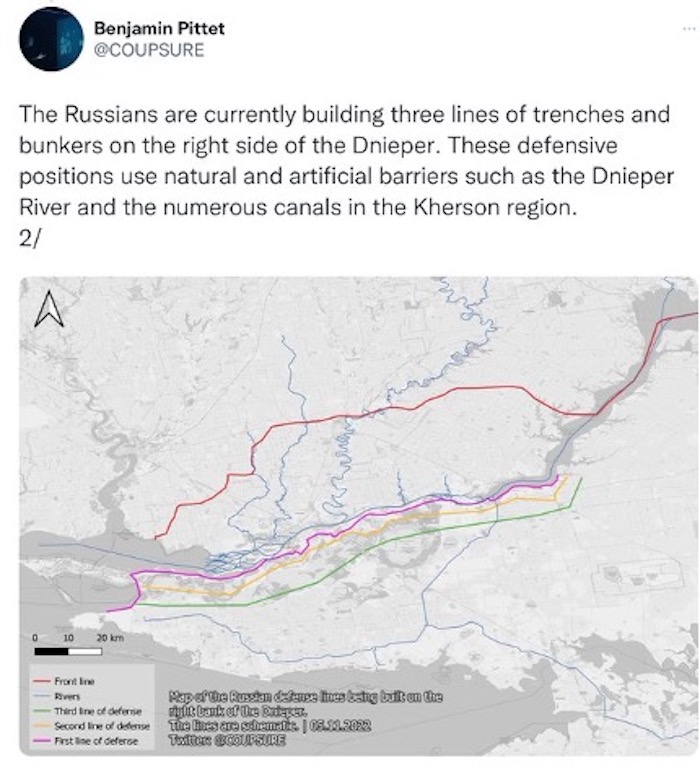
A seventh point: this is a validation of Ukraine’s military strategy and the approach taken by its senior leadership. They are succeeding and the Russians know it. This will also provide a morale boost for Ukraine going into winter.
Finally, now is NOT the time to force Ukraine into negotiations. The Russians might be weakened but they are not giving up on their territorial aspirations. They will have to be beaten on the battlefield and pushed out of Ukraine. Which is why the west should supercharge its provision of equipment (including tanks), munitions and training to Ukraine. We have a profound obligation to help the Ukrainians end this war more quickly.
There are still many uncertainties about this potential withdrawal by the Russians. And, it is a realignment of Russian forces, not a surrender. The Ukrainians have many more fights ahead of them to clear their lands of the Russian invaders.”
Russian claim of Kherson withdrawal may be part of psyops, Ukrinform reports. “The statement voiced by the Russian command on the pullback of their forces from Kherson in southern Ukraine may be part of a psychological operation to create a false impression about their true intentions. That’s according to Nataliia Humeniuk, head of the joint coordination press center of the Southern Defense and Security Forces, who commented for Suspilne on the situation around Kherson.
Our defense forces do not rule out provocations on the part of the Russian occupiers as they might be creating a false impression about their true intentions, the spokesperson said.”
Army well-staffed so far, any new call-up to depend on frontline developments - deputy defense minister, Ukrinform reports, citing Deputy Minister of Defense Hanna Maliar. “The Armed Forces of Ukraine is currently sufficiently stuffed, but in the event of a change in the situation on the front line, an additional mobilization effort may be launched.”
- Consequences and what to do?
Further blackouts may shrink GDP by 39% - Ministry of Economy, Ukrinform reports, citing Yulia Svyridenko, First Deputy Prime Minister, Minister of Economy. "According to our calculations, if the blackouts continue for the next few weeks, Ukraine's GDP will decrease even more – by 39%, the head of the Ministry of Economy said.
She emphasized that power outages affect not only households, but also businesses and companies that are forced to suspend operations. The Ukrainian economy has already suffered as a result of the war due to the occupation of certain territories of Ukraine, where metallurgical and other large enterprises are located, as well as the destruction of infrastructure, outflow of labor and capital, and many other factors. In addition, supply chains have been seriously disrupted.
If more problems with destroyed power networks are added to the list, our GDP will fall even more, noted Svyridenko.”
Thousands march as Greeks strike over 'suffocating' inflation, Reuters reports. “Greek workers went on a day-long strike on Wednesday, demanding higher wages to cope with surging inflation, as Europe's soaring energy prices and living costs trigger industrial action and protests across the continent.
It is the latest labour action in Europe, where a growing cost of living crisis and rising energy prices following Russia's invasion of Ukraine have led to strikes this month in Britain, France, Spain, and Germany, the region's biggest economy.
The Greek economy is growing at nearly twice the euro zone rate this year thanks to a rebound in tourism, but inflation is near a three-decade peak at 12%, among the highest in the zone's 19 member countries.”
Euro zone consumers see higher inflation ahead, ECB says, Reuters reports. “Inflation expectations among euro zone consumers continued to rise in September, even as economic growth and income forecasts declined markedly, a new European Central Bank survey showed on Wednesday.
Inflation has been hitting new records month after month, raising fears that wages, still growing relatively slowly, will eventually follow, setting off a hard-to-beat wage-price spiral.
But the survey appears to indicate that inflation and income growth will remain misaligned, offering some relief for the ECB, which has already raised rates by 200 basis points in three months in its fastest tightening cycle on record.”
Hans Petter Midttun: Today’s assessment will be published as a separate article. A teaser:
“Two events caught the world's attention yesterday. First, the Russian Ministry of Foreign Affairs announces its readiness for negotiations without any conditions "taking into account the current state of affairs". Secondly, Russia decided to surrender the west bank of Kherson Oblast and withdraw its forces across the Dnipro River.
The decision to withdraw is seen as military sound in light of their logistic problems as a result of months of Ukrainian precision strikes against bridges, depots and concentration of manpower and equipment. The Russian forces have been persistently pushed back in the face of an increasingly stronger Ukrainian counteroffensive. The 20,000 to 30,000 troops on the West Bank of the Dnipro river include some of Russia’s few remaining elite units, like elements of the 76th and 106th Airborne Assault Divisions and 22nd Army Corps.
While the decision marks a huge political defeat for President Putin, coming slightly more than a month after he announced the annexation of the region and after allegedly, previously having refused requests to withdraw, it is nevertheless supported by the Russian pro-war forces.
The decision to withdraw does not necessarily mean that the operation will be successful. It will involve an extremely complex, fighting withdrawal taxing for even the most professional Army. The Russian Armed Forces have proven itself anything but professional during the last 9 months of full-scale war.
Russia does not need negotiations to end the war. It simply needs to withdraw all of its forces from Ukraine, unblock the Ukrainian ports, and stop all attacks on land, in the air and from the sea.
Russia is not offering peace. It is de facto escalating the war into a Total War.
Its “new” offer for negotiations, is very much in line with Russia’s hybrid war strategy and previous “offers of a peaceful resolution of the war”. Russia is offering a negotiation because its crucial to its intention to relaunch the military offensive.
The report explains why.”

